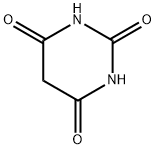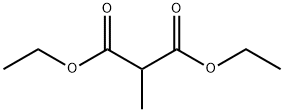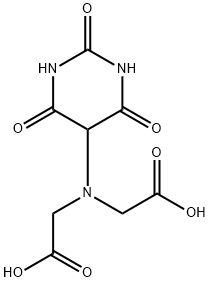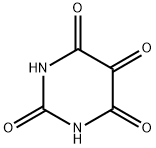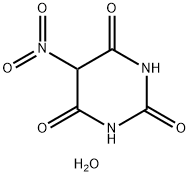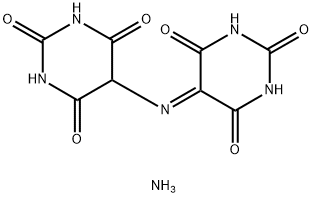Barbituric acid , 98% , 67-52-7
Synonym(s):
2,4,6-Trihydroxypyrimidine;2,4,6-Trihydroxypyrimidine, N,N′-Malonylurea;Barbituric acid;Fluorouracil Impurity A (PhEur);Malonylurea
CAS NO.:67-52-7
Empirical Formula: C4H4N2O3
Molecular Weight: 128.09
MDL number: MFCD00006666
EINECS: 200-658-0
| Pack Size | Price | Stock | Quantity |
| 25G | RMB23.20 | In Stock |
|
| 100G | RMB84.80 | In Stock |
|
| 500G | RMB287.20 | In Stock |
|
| 2.5KG | RMB979.20 | In Stock |
|
| others | Enquire |
PRODUCT Properties
| Melting point: | 248-252 °C (dec.) (lit.) |
| Boiling point: | 260℃ (decomposition) |
| Density | 1.6006 (rough estimate) |
| bulk density | 720kg/m3 |
| refractive index | 1.4610 (estimate) |
| Flash point: | 150 °C |
| storage temp. | Store below +30°C. |
| solubility | 11.45g/l |
| pka | 4.01(at 25℃) |
| form | Powder/Solid |
| color | Light Cream |
| PH | 2-3 (50g/l, H2O, 60℃) |
| Odor | Odorless |
| Water Solubility | 142 g/L (20 ºC) |
| Merck | 14,963 |
| BRN | 120502 |
| InChIKey | HNYOPLTXPVRDBG-UHFFFAOYSA-N |
| CAS DataBase Reference | 67-52-7(CAS DataBase Reference) |
| NIST Chemistry Reference | Barbituric acid(67-52-7) |
| EPA Substance Registry System | Barbituric acid (67-52-7) |
Description and Uses
Barbiturates are derivatives of barbituric acid, barbituric acid is formed by the condensation of malonic acid and urea, itself has no anesthetic effect, but if its C2 and C5 atoms are substituted by different genes, it can generate many species of barbiturate agents ,for example, oxygen of C2 is replaced by sulfur, which generates sulfur barbiturates, such as thiopental.
Barbiturates'mechanism is basically the same, they act on different levels of the central nervous system, and have a non-specific inhibition. Its sedative and hypnotic effects may be related to selective inhibition of thalamic reticular upstream activating system , thereby blocking the excite transduction to cerebral cortex. Its Anticonvulsant effect is performed through inhibiting synaptic transmission in the central nervous system ,to improve the electrical stimulation threshold in motor cortex.
barbiturates having a therapeutic effect play a inhibiting role in the central nervous system , such as phenobarbital (phenobarbitone), amobarbital (amylobarbitone), thiopental , methohexital (methohexi-tone ). Inhibitory barbiturates have sedative, hypnotic, anticonvulsant and anesthetic effects, but its sedative-hypnotic agent has been eliminated, because in the process it is easy to produce severe tolerance, drug dependence and drug liver enzyme induction.
Because of some differences in their chemical structure, the body eliminate and fat-soluble manner of every drug are different , thus the speed of appearing effect and time of continuing also vary . Long-acting barbiturates such as phenobarbital (phenobarbi-tone) are still used in the treatment of epilepsy anticonvulsant. Ultrashort acting barbiturates (thiopental and methohexital) are often applied as an intravenous anesthetic.
Barbiturate intravenous anesthetics used clinically are now about ten kinds, but three to five species are commonly used . According to the view of Anesthesiology, barbiturates can be divided into two categories, namely hypnotic barbiturates and barbiturate anesthesia. The former are markedly slower drugs such as phenobarbital,having a sedative effect, before anesthesia,its administration can make the patient quiet. After intravenous injection of the latter, consciousness soon disappear,it is mainly used for general anesthesia, in which the most commonly used drug is thiopental, so this drug is representative.
Phenobarbital is a barbituric acid derivative, having weak acid,it is the central inhibitor, mainly inhibiting brain ascending reticular activating system. The shallow to deep degree of inhibition of the drug are due to the amount of small to large ,it has different levels of sedative, hypnotic and anticonvulsant, anesthetic effect. In addition, the drug also has antiepileptic effect.
The above information is edited by the chemicalbook of Tian Ye.
Barbituric acid is widely used in the manufacturing of plastics, textiles, polymers and pharmaceuticals. It is an active ingredient in the production of Vitamin B2. It is a strong acid in an aqueous medium with an active methylene group involved Knoevenegal condensation. It is used as precursor for the preparation of 5-arylidene barbituric acid by reacting with aromatic aldehyde. It is also used in electrochemical oxidation of iodine using cyclic voltammetry and controlled potential coulometry.
Safety
| Symbol(GHS) |  GHS07 |
| Signal word | Warning |
| Hazard statements | H315-H319-H335 |
| Precautionary statements | P261-P280a-P304+P340-P305+P351+P338-P405-P501a |
| Risk Statements | 36/37/38 |
| Safety Statements | 24/25 |
| WGK Germany | 1 |
| RTECS | CP8000000 |
| TSCA | Yes |
| HS Code | 29335200 |
| Toxicity | LD50 orally in Rabbit: > 5000 mg/kg |

